Best mods for the 1997-2003 MK4 Golf
"Tuning for the MK4 from 1997 to 2003 (90-225hp)"
Based on my personal experiences with the 1.8T and 1.9TDi engines, here is a guide on tuning and mods. To help you out, below are some of the modifications and improvements that worked best for me, as well as some suggestions for other Golf modifications.
VW's design team came up with the Golf MK4 design to compete with the A3, BMW 3 Series, and Ford Focus, one of the most significant targets in the European automotive business the luxury compact. In other words, the Golf is Volkswagen's answer to the premium small vehicle market and achieved the best selling car status in Europe in 2001.
If you want tips on other Golf models see also our tuning guides forMk3 Golf Mods, Mk4 Golf Mods, Mk5 Golf Mods, Mk6 Golf Mods and MK7 Golf mods.
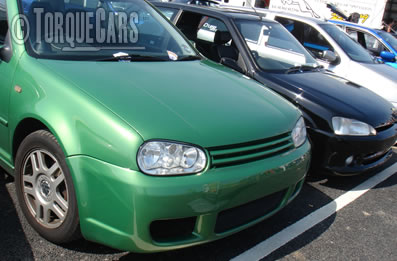
This was part of the transition to using a modular design and sharing engines and parts across the VAG group, with many similarities to the A3 but the Golf had more engine options and also acquired some Audi tech.
Volkswagen introduced the Haldex (Quattro) drivetrain to this model, for some higher powered engines, which gives 4 wheel drive when traction is lower but seamlessly reverts to FWD for most everyday conditions.
The body panels were much thicker than on the later Mk5 version, and despite the fact that the internal capacity was limited, it radiated excellent construction and was very well assembled.
The torsion beam rear suspension was also problematic and didn't create an agile handling characteristic, however it did offer lift off oversteer which could be fun when properly exploited.
Please watch our video introduction to VW Tuning.
When purchasing an early Mk4 model, steer clear of the weak 1.4, 1.6 and 2.0 litre (non-turbo) and the 1.9 SDi, the 1.8T and 1.9Tdi are all lively power plants well suited to the Golf and the 3.2 R32 and VR6 versions have acquired an almost cult like following in the tuning community.
It's easy to spend your free time modifying a Volkswagen Golf over the weekends. Don't be deceived, there are a lot of sports uniforms out there that don't fit the bill for your Golf, so prepare beforehand. Make sure you've checked over our impartial guidelines before moving on to the next step.

Golf MK4 Engine Tuning.
We receive a lot of queries from our readers like, "What VW Golf improvements are available?" VW Golf remapping: is it possible? Can the VW Golf can be tuned or modified? So these are the 8 best and most effective Golf modifications that we've rounded together for your convenience.
Best mods for your Golf MK4
- Engine Tunes - A tune/remap gives the biggest gains for your outlay, replacement ECUs, and piggyback ECUs are all alternatives.
- Brake Upgrades - Improve your ability to stop ought to be near the top of your Mods list.
- Head work - The goals of porting and flowing the head are to get air flowing into the engine while removing flow restrictions and turbulence.
- Turbo upgrades - Adding a turbocharger is the most dramatic method to increase your intakes air supply, which permits you to utilize more fuel and make more power. Typically one of the most complex mods it does provide the largest gains.
- Golf MK4 Handling Mods (Suspension) - Replacing worn bushings and shocks dramatically improves Golf MK4 handling Coilovers and Bushings are the usual go to mods but also fit a strut brace to tighten up the front end.
- Intake Upgrades and high flowing exhausts - Be aware on their own these mods will NOT ADD HP , but they can help enhance power after other modifications by lessening the restrictive flow.
- Fast road cams are significant power adders, but TorqueCars recommend they be fitted by someone competent and some cams are hard to find but you might find a local firm to regrind a stock camshaft for you.
- Lighter flywheels - a lower mass flywheel will significantly improve the engines ability to rev freely. Not beneficial for all Golf MK4 engines.
Golf MK4 Tuning Stages
Typical stage 1 mods often include: Alloy wheels, Lighter flywheel, Suspension upgrade (drop ), Engine Tunes/Remapping, Sports exhaust, Panel air filter.
Typical stage 2 mods often include: fuel pump upgrades, Ported and polished head, Fast road cam, Power/Sport clutch, high flow fuel injector.
Typical stage 3 mods often include: Sports gearbox, Adding or upgrading forced induction (turbo/supercharger), Internal engine upgrades (pistons/head/valves), Engine balancing, Competition cam.
Golf Engine Codes and Specs
| 1.4 | 1998–2004 | AHW/AXP/BCA/AKQ/APE/AUA | 55 kW (75 PS; 74 hp)@5,500 rpm | 128 Nm (94 lbft)@3,300 rpm |
| 1.6 | 1998–2000 | AEH/AKL/APF | 74 kW (101 PS; 99 hp)@5,600 rpm | 145 Nm (107 lbft)@3,800 rpm |
| 1.6 | 2000–2006 | AVU/BFQ | 75 kW (102 PS; 101 hp)@5,600 rpm | 148 Nm (109 lbft)@3,800 rpm |
| 1.6 | 2000–2006 | AUS/AZD/ATN/BCB | 77 kW (105 PS; 103 hp)@5,700 rpm | 148 Nm (109 lbft)@4,500 rpm |
| 1.6 FSI | 2002–2005 | BAD | 86 kW (117 PS; 115 hp)@5,800 rpm | 155 Nm (114 lbft)@4,400 rpm |
| 1.8 | 1998–2006 | AGN/BAF | 92 kW (125 PS; 123 hp)@5,900 rpm | 170 Nm (125 lbft)@3,500 rpm |
| 1.8 T | 1998-2001 | AGU/ARZ/ARX/AUM/BAE | 110 kW (150 PS; 148 hp)@5,500 rpm | 210 Nm (155 lbft)@2,200–4,200 rpm |
| 1.8 T | 2001-2006 | AUQ/AWP/AWW/AUG | 132 kW (179 PS; 177 hp)@5,500 rpm | 235 Nm (173 lbft)@1,950–4,700 rpm |
| 2.0 | 1999–2001 | AEG/APK/AQY | 85 kW (116 PS; 114 hp)@5,200 rpm | 170 Nm (125 lbft)@2,400 rpm |
| 2.0 | 2001–2006 | AZJ/AZH | 85 kW (116 PS; 114 hp)@5,400 rpm | 172 Nm (127 lbft)@3,200 rpm |
| 2.3 VR5 | 1998–2000 | AGZ | 110 kW (150 PS; 148 hp)@6,000 rpm | 205 Nm (151 lbft)@3,200 rpm |
| 2.3 VR5 | 2000–2003 | AQN | 125 kW (170 PS; 168 hp)@6,200 rpm | 220 Nm (162 lbft)@3,300 rpm |
| 2.8 VR6 | 1999–2002 | AAA/AFP | 128 kW (174 PS; 172 hp)@5,800 rpm | 235 Nm (173 lbft)@4,200 rpm |
| 2.8 VR6 | 1999–2002.5 | AQP/AUE | 150 kW (204 PS; 201 hp)@6,000 rpm | 270 Nm (199 lbft)@3,200 rpm |
| 2.8 VR6 | 2002.5–2005 | BDF | 150 kW (204 PS; 201 hp)@6,000 rpm | 270 Nm (199 lbft)@3,200 rpm |
| 3.2 R32 | 2001–2004 | BJS/BML | 177 kW (241 PS; 237 hp)@6,250 rpm | 320 Nm (236 lbft)@2,800 rpm |
| 1.9 SDI | 1998–2006 | AGP/AQM | 50 kW (68 PS; 67 hp)@4,200 rpm | 133 Nm (98 lbft)@2,200–2,600 rpm |
| 1.9 TDI | 1998–2006 | AGR/ALH | 66 kW (90 PS; 89 hp)@4,000 rpm | 210 Nm (155 lbft)@1,900 rpm |
| 1.9 TDI | 2000–2006 | ATD/AXR (Pd) | 74 kW (101 PS; 99 hp)@4,000 rpm | 240 Nm (177 lbft)@1,800–2,400 rpm |
| 1.9 TDI | 1998–2002 | AHF/ASV | 81 kW (110 PS; 109 hp)@4,150 rpm | 235 Nm (173 lbft)@1,900 rpm |
| 1.9 TDI | 1998–2000 | AJM (Pd) | 85 kW (116 PS; 114 hp)@4,000 rpm | 285 Nm (210 lbft)@1,900 rpm |
| 1.9 TDI | 1999–2001 | AUY (Pd) | 85 kW (116 PS; 114 hp)@4,000 rpm | 310 Nm (229 lbft)@1,900 rpm |
| 1.9 TDI | 2001–2006 | ASZ (Pd) | 96 kW (131 PS; 129 hp)@4,000 rpm | 310 Nm (229 lbft)@1,900 rpm |
| 1.9 TDI | 2000–2003 | ARL (Pd) | 110 kW (150 PS; 148 hp)@4,000 rpm | 320 Nm (236 lbft)@1,900 rpm |
You can find links to our Golf engine tuning guides on the links below, which provide a wealth of information on how to improve the performance of these engines. Even though swapping engines from a different vintage is sometimes easier, many of these would be strong candidates for engine replacements.

- 1.4 1.5 TFSi tuning
- 1.4 TSi/TFSi/Twincharge tuning
- 1.8T engine Tuning
- 1.8 & 2.0 TFSi (mk1) Tuning
- 1.8 2.0 TFSi (ea888) Tuning
- 2.0 TFSi carbon issue & care guide
- 2.5tfsi tuning
- 3.0 V6 24v TFSI Tuning
- 2.8 V6 30 valve, 24 valve 3.0 V6 30v and 3.2 VR6 Tuning
- 3.6 VR6 Tuning
- 1.6 TDi tuning
- 1.9 TDi tuning
- 2.0 TDI 140-170 tuning
- 2.0 TDI tuning (EA188)
- 2.5 TDI tuning
- 2.7 & 3.0 TDI tuning
VW Golf performance tuning
Are there some engines that are better than others? The 1.9TDi and 1.8T that we tested worked well with the automobile. These engines also have a wide range of tuning possibilities, which may result in significant power improvements with the 1.8T AGU block handling power to around 350hp.
Best VW Golf modifications
Looking down the engine specs we could answer the often asked question does the VW Golf have a turbocharger? Turbocharged engines were not included in every vehicle but most had a turbo fitted.
The VR5 and VR6 are pretty good for NA engines, but the rest without a turbo are relatively weak and don't provide impressive results when modified they can still be modified though but a 15% gain on them is quite expensive on these I would focus on handling and suspension upgrades. We propose the 1.8 Turbo and Turbo Diesel engines for your Golf tuning project since they are great to work on and have plenty of upgrades.
Golf MK4 Turbo Upgrades
The K03 turbo was available for a limited time between 1996 and 2000. On the 1.8T engine, which is powerful, the K03s turbos are employed (AGU has forged parts). The early engines utilise smaller injectors and a MAF sensor.
The K03s turbos are generally utilised in engines that have the MAF and MAP sensors. Fuel efficiency and performance are both increased because to the introduction of a better drive-by-wire throttle in these engines.
Upgrades to the KO3 turbo's 12 blades can create around 200 horsepower, while the K03s turbo's 8 blades can produce 220 to 250 horsepower under similar conditions.
The turbo on the K04 was larger, and it came in three distinct configurations (some suited to the transverse engine layout in the A4)
- K04-020 The temperature gauge aperture is absent in K04-022.;
- A temperature gauge aperture may be found in part number K04-023..
- An aperture for a temperature gauge does not exist in K04-022.;
With a few tweaks, this K04 should be able to flow up to roughly 300bhp on the standard 1.8T and easily output 250bhp when remapped. If you want to get the most out of these turbos, you'll need to upgrade your air intake and intercooler.
Engine codes BBU, BE, BJX, BVP, ARY, AUQ, AWV, and K03S were determined to include K03S.
It's simple to upgrade engines with a K03 turbocharger to one with K04 turbochargers.
Despite the intricacy of the software, most customers report that the K04 turbo works well with the factory manufacturer's ECU Map but you should tune/remap it for maximum power gains.
VW tuners advocate engine tuning/remapping the factory KO3 engine and setting the boost to 1 bar, then looking for a better flowing turbo like the K04 or a solid hybrid to replace it with when it breaks down which it will at these power levels.
A track day or drag strip turbo, the KO4 still has plenty of power when the KO3 starts losing power at 5000 rpm.
The KO4 changes the characteristics of the engine and makes pulling hard more enjoyable. Because of this, you may anticipate the K04 to perform speedier in low-boost power situations, however this is not true it does have more lag than either of the K03 options.
It's easy to get aftermarket turbos that fit the factory downpipe and may be customised to suit your requirements. These turbos satisfy the needs of many drivers who seek both excellent fuel efficiency below 2500 rpm and high power output between 3000 and 5500 rpm.
As long as you don't intend to replace your turbo within the next few years, you should stick to the safe turbo limitations indicated below. Increasing the turbo's maximum boost pressure can reduce the turbo's lifetime.
| Turbo | Safe Max | Maximum |
| K03 | 190hp | 220hp |
| K03s | 215hp | 250hp |
| K04 | 220hp | 350hp |
A Stage 1 tune/remap of your Golf's K03s turbo should provide between 210 and 220 horsepower, with a few minor tweaks (Air filter, exhaust, bolt-on modifications).
Golf Handling/Suspension Upgrades
Improving the handling should be your first focus in your Golf tuning efforts especially to address what I, and many others, consider to be the MK4 Golfs Achilles heel.
Handling on the Golf MK4 will improve significantly with a good set of coilovers. Due to the design of the rear suspension (torsion beam), they were prone to lift off oversteer, but they also suffer from severe body roll.
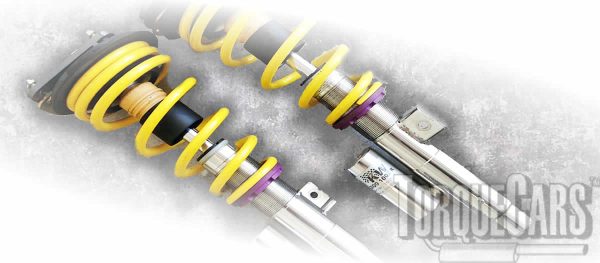
A strut brace will mitigate some of this, as will better quality suspension components and a modest drop.
On the majority of models, we'd aim for a drop between 23 and 39 percent. Going lower than this might result in compromises. Consider that the sport versions already have reduced suspension..
Upgrades to the Golf's suspension and handling
The Golf tuner's first step is frequently handling modifications, and there is a plethora of alternatives to consider, but quite a few options will not improve the handling, and some will cause it to deteriorate, so let's look at your best options. To tighten the suspension geometry, we'd install a front strut brace first up, the suspension mounts will sag outwards over time to the detriment of your cornering.
If your Golf is a daily driver, what elements must you take into account while setting up and choosing your suspension?
Uprated Bushes
If you hear a rattling or squeaking sound coming from the back of your car, the most likely culprit is the rear suspension bushes.
If you don't remove the worn bushes and replace them, your car's handling will suffer severely and the bushings, especially on the rear will take a real beating.
Things to know about improvements to the bushings:
- You could choose a set of Poly bushes, which replace the original mounts and there are various grades of rubber ones available.
- Hard bushings can cause the suspension to give up more vibration and rattles, not good for comfort or handling.
- Combining rubber and poly bushes can help you fine tune your Golfs handling.
- Worn Bushings really compromise your MK4 Golf's handling.
Bushes are used to attach the Golf's suspension components to the chassis. There is no reason why you can't change your rubber ones to something more durable but you need some flex in them, so softer poly bushes are my preference.
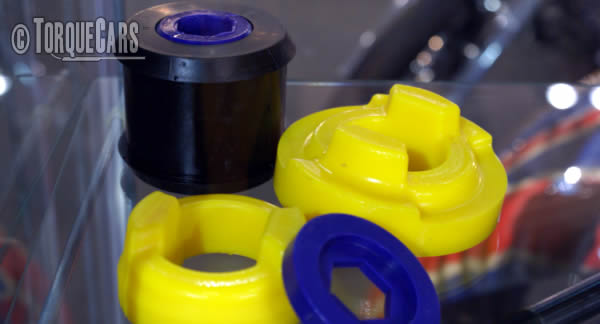
To compensate for the bumpier ride they can cause, the polyurethane bushes are designed to last longer and to retain the vehicle's handling for longer periods of time.
Although we can now obtain softer poly bushings for the rear suspension mounts, I'll let you know how these function in the comments below if I try them (and if you have, please share your experience).
Polyeyurothane bushes may alleviate some of the excessive play that is often caused by rubber bushes so I consider these a good upgrade option.
How low should you go on the Golf?
There is a maximum and optimum suspension drop of 23 - 39 millimetres for most road vehicles, according to TorqueCars research and testing, whereas the maximum suspension drop for Golfs that are factory equipped with reduced height and stiffer springs is 20 millimetres (R32 for example).
If the wheel size is modified, these tolerances may be significantly reduced. If the car has 17-inch wheels and the factory suspension, lowering it may result in a great deal of issues. Stiffer suspension can prevent the tires rubbing on the arches.
Even though lowering the Golf might help with stability, the primary focus should always be on improving the car's handling and straight line grip. When using lower springs, it is essential to utilise the correct shocks or you'll just create bounce.
We discovered that the stock suspensions on most Golfs can be improved with just a few degrees of toe (a little toe out for better cornering or a little toe in for greater stability) and adding a degree of negative camber (this has to balance out with straight line grip though so some fine tuning is required.)
Golf MK4 Brake Upgrades
It doesn't matter what kind of car you're working on; improving your brakes is a great place to start. Brake pads are just as vital as discs, if not more so, and choosing the wrong pad material may have a big impact on your Golf's braking performance as well as the life of your discs.
Brake Pad recommendations
Simply by adding high-quality brake pads, you may boost your Golf's stopping ability.
Drivers need to bear in mind that race-spec pads are designed to function at higher temperatures than stock pads. It means they can stay on the track even when they're boiling hot and the braking will not fade.
However, road use is discouraged because of the race pads inability to bite when cold; yet, it may only take a second or two for them to warm up and begin biting, it will generally cause longer stopping distances than other choices on a road car.
The many heating and cooling cycles contribute to a reduction in pad friction as the pads become older.
A set of Pagid brake pads I fitted on my Golf is capable of performing well on the road and at the track. Despite the fact that the EBC Greenstuffs produced less dust and worked just as well, I still prefer the Pagid pads.
Please join our forums to get suggestions from our users, who have tried a range of different products and given their feedback and recommendations.
Better performance brake pads should be used in conjunction with larger brake discs for considerable improvements in stopping power.
It is important to keep in mind that racing pads may grind and must be heated before they bite.
The brakes are only used once or twice every 15 minutes, they won't be able to stop you as effectively if you choose friction pads with a low operating temperature (race spec pads).
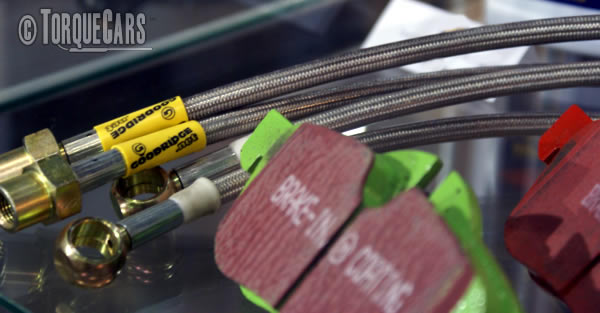
Tips for cheap brake Mods on your Golf MK4
Check to see whether your 1.4 or 1.6's has 256 or the larger more flexible 288mm discs to ensure the new ones will fit before ordering an upgrade. If they don't, a hub replacement may be necessary. If you're a bigger person, you have a lot more possibilities for upgrading.
When upgrading your Golf, for example, you may go from a 1.8 Golf to a 2.8 Golf or an R32 with relative ease.
It's good to know that there are a variety of options to choose from, including 4 and 6 pot calliper conversions, vented, drilled, and grooved, and even costly huge brake kits.
In comparison to the cost of an aftermarket setup, most Golf drivers will be quite content with a slightly larger set from the R32 or Audi S or RS series of cars. For a much cheaper money, you can pick one of them up from a salvage yard or used market (see our store link at the top to find sources of these).
Your brakes are just there to stop the vehicle, not to tear up the asphalt on which it is running! So please don't overdo it, you cannot exceed your grip levels when braking!
To improve a car's stopping power, new callipers and pads are required to accommodate bigger discs.
In most situations, discs and pads should be replaced when braking improvements are required. The additional friction and heat dissipation that comes with a bigger disc will immediately help you and the pads will be all the more effective.
Remapping your Golf MK4
What is the cost of engine tuning/remapping an VW Golf's engine? For a good remap, anticipate to spend between £250 and £400, or $350 and $600 in US dollars, depending on who you go to and where you reside.
Performance tuning table for the Golf
Figures in the table below assume that the 1.8T Golf will weigh in at 1400kg (with ballast and driver) and have a manual gearbox, therefore we'd expect it to hit 170-225hp for most common projects.
| Base power | Quarter Mile |
Tuned to |
Kerb Weight |
Quarter Mile |
| 115hp | 18.29 | 120hp | 1400kg | 18.04 |
| 150hp | 16.79 | 170hp | 1400kg | 16.12 |
| 185hp | 15.69 | 225hp | 1400kg | 14.73 |
| 640hp | 1400kg | 10.99 | ||
| 550hp | 1200kg | 10.99 |
Even with a sophisticated setup and differential, you'll have trouble putting down more than 225 horsepower in a front-wheel-drive Golf, so go for an all-wheel-drive or haldex/quattro system instead.
Original equipment manufacturer (OEM) maps are notorious for their poor quality due to the conservative settings used. In most circumstances, it is required to tweak the fuel, spark, and boost to match local fuel emission requirements and temperatures in order to get a single configuration for everyone.. for everywhere.. for every environment..
The fact that various nations use different types of gasoline and have variable degrees of bad weather necessitates the creation of a global standard MAP so compromise is the order of the day here.
Be wary though when mappers give promises of excessive peak horsepower and torque. Additionally, some tuners have been known to elevate their power output for the sake of drawing attention and boosting headline power statistics while masking their map profile's shortcomings.
The graph below provides a visual representation of this.
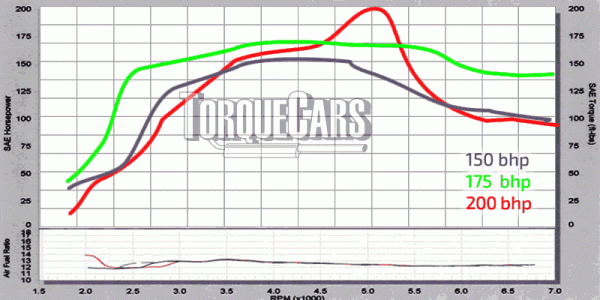
Even if the red line shows a 200-horsepower jump, comparing it to the green line's 175-horsepower rise shows a completely different tale where the red trace just has one high peak and is lower everywhere else.
Knowing that the engine's peak power is at 4000 rpm is very useful for an engine that hits 7000 rpm's redline and the green trace gives good boost from 2200rpm to 6000rpm spreading out this peak, avoiding excessive bottom end power or sudden spikes.
Golf MK4 Alloy Wheel Upgrades
What are the most common modifications for Golf Alloy Wheels, and what size do we recommend? What are the advantages of installing alloy wheels on your vehicle?
The unsprung weight of your car may be reduced, and the brakes can be better cooled, using alloy wheels. However, if they are bigger, these advantages will be lost.
Due to the fact that tyres are so critical to a car's ability to put power down on the road, we can't go into extensive detail about them here so see our tyre articles. Tread patterns that are specifically designed for the Golf make a big impact in the performance of the vehicle, we quite like Pirelli Pzero, Michelin Pilots, Dunlop SP Sport Maxx, Goodyear Eagle F1 and Continental Sport as we've tried these and they worked really well. (NB: The Eagles we used did wear quite quickly but I understand the compound used has since been revised)
Large Golf alloy wheels may have an impact on the vehicle's performance. Your final drive ratio will be affected if you install larger alloy wheels on your car.
Keeping this in mind, it's best to keep the overall diameter of the wheel at the value given by the manufacturer. We don't recommend going any larger than 17 inches in any scenario.
A comparison Golf with 17-inch wheels helped me realise that the 18-inch wheels made the car seem sluggish and distract from its excellent handling.
I'd happily run on 18s if I had to, but I like the way 17s handle. In this case, weight is a major consideration, as light 18s may not feel very different from 17s.
Living with an Golf MK4
When shifting into 1st and occasionally 2nd gear on a cold gearbox with short rides, the Mk 4's gear change might be a touch notchy at times. This may be improved with the use of a rapid shift kit.
Make sure the transmission oil is full and avoid using heavy vehicle mats.
You read it correctly. Every millimetre of clutch pedal motion is required. My mats had restricted the clutch travel, as I discovered the hard way, and that was the source of my gear crunching!
There are a few problems and issues to look out for on other popular vag group engines, but I've split these off into other articles.
- 2.0 TFSi carbon buildup issues - direct injection engines require an intake clean.
- 2.0 TFSi problems - N75 and N249, high oil consumption, Cam Follower wear, Water Pump failure, and Turbo issues
- 2.0 TDi problems - Flywheel, Oil pump, Lumpy Idling
- 1.8T Problems - Diagnosing the common faults and issues
Please join us in our forum to discuss the Golf 8P options in more detail with our Golf 8P owners. It would also be worth reading our Golf MK4 tuning articles to get a full grasp of the pros and cons of each type of modification.
Please Check out my YouTube channel, we're regularly adding new content...
PLEASE HELP: I NEED YOUR DONATIONS TO COVER THE COSTS OF RUNNING THIS SITE AND KEEP IT RUNNING. I do not charge you to access this website and it saves most TorqueCars readers $100's each year - but we are NON PROFIT and not even covering our costs. To keep us running PLEASE Donate here
If you liked this page please share it with your friends, drop a link to it in your favourite forum or use the bookmarking options to save it to your social media profile.
Feedback - What do You Think?
Please use our forums if you wish to ask a tuning question, and please note we do not sell parts or services, we are just an online magazine.
Help us improve, leave a suggestion or tip
Please watch this video and subscribe to my YouTube channel.

 Click to accept YouTube Cookies & Play.
Click to accept YouTube Cookies & Play.